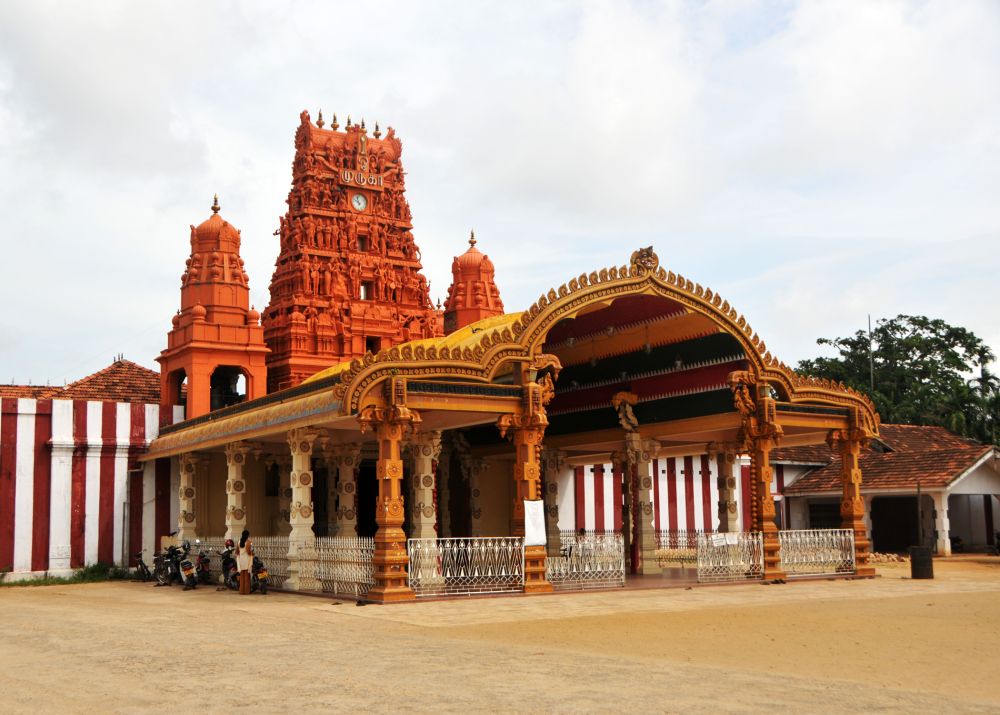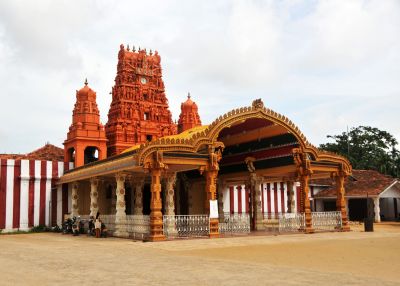

Nallur Kandaswamy Kovil, one of the most significant Hindu temples in Jaffna, Sri Lanka, extends a serene and spiritual experience to its visitors. Attending the morning pooja, a ritualistic worship, provides an opportunity to immerse oneself in the temple's divine ambiance. The pooja begins with the ringing of the temple bell, signaling the opening of the shrine for worship. Devotees gather to perform their prayers, light oil lamps, and offer fruits and flowers to Lord Murugan, the presiding deity. The air resonates with the chants of religious hymns, providing a calming and rejuvenating start to the day. Attendants conduct the ceremony with a series of offerings and rituals, culminating in the aarti, where camphor is lit in a ceremonial flame and offered to the deity.
The Nallur Kandaswamy Kovil is an architectural marvel, boasting a majestic gopuram (tower) richly adorned with colorful statues and intricate carvings. Exploring the temple's architecture invites visitors to appreciate the artistry of the craftsmen who built it. The temple has been reconstructed several times, with the current structure dating back to the 18th century. Its layout is in the traditional Dravidian style, featuring beautifully painted walls, ceilings, and pillars that each tell a story from Hindu mythology. Visitors can observe the detailed work on the vimana (tower above the sanctum) and the mandapams (pavilions) which are lined with rows of sculpted pillars, each uniquely decorated. The temple's expansive courtyard is used for festivals and ceremonies and is surrounded by a series of smaller shrines dedicated to different deities.
For photography enthusiasts and cultural explorers, a photography session at Nallur Kandaswamy Kovil presents an opportunity to capture the exquisite detail and vibrant life that characterizes this holy place. The temple's grand red and white exterior, towering gopuram, and intricate sculptures offer a visually stunning tableau. Visitors can photograph the bustling atmosphere during pooja times, the silent, reflective moments of solitary worshippers, or the elaborate rituals during festivals. It's essential to maintain respect for religious practices and the devout by not intruding on private moments or disrupting the temple activities with photography. Always seek permission before taking pictures of people and be mindful of areas where photography might be restricted.
Nallur Festival is one of the longest and most elaborate Hindu festivals in Sri Lanka, spanning over 25 days between July and August. Participants have a chance to witness and be part of vibrant processions, religious performances, and cultural events. The festival features the Ther Thiruvila, the chariot festival, where the deity Lord Murugan is paraded around the temple in a richly decorated chariot pulled by devotees. There are also the Teertham rituals, where sacred water is sprinkled on the worshippers, and the Poojas that occur multiple times throughout the day. Visitors experience a unique blend of devotion, culture, and tradition during this period, with the opportunity to see traditional music, dance performances, and receive prasadam (holy food).
Music and dance are integral parts of the worship experience at Nallur Kandaswamy Kovil. Visitors can often witness traditional Bharatanatyam dance performances and Carnatic music recitals. Both art forms are deeply spiritual and are performed as offerings to the deities. These performances typically take place during special ceremonies and on festival days within the temple premises. Bharatanatyam dancers, adorned in colorful costumes and jewelry, tell stories of gods and goddesses through precise gestures and facial expressions. Carnatic musicians, with their classical instruments such as the veena (a string instrument) and mridangam (a percussion instrument), add a rhythmic melody to the ambiance. This cultural immersion broadens one's appreciation for the ancient arts of the Tamil people.
Visiting Nallur Kandaswamy Kovil provides a fascinating insight into the practices and rituals of Hindu worship. Observing rituals like the Abhishekam, where the deity is bathed with holy water, milk, and other sanctified liquids, allows visitors to witness the dedication and care taken in the preservation of spiritual traditions. During important days in the Hindu calendar, special poojas and rituals take place, offering a window into the rich tapestry of Hindu culture. Devotees actively participate in rites such as making offerings of fruits and incense, chanting mantras, and receiving blessings from the priests. It’s an immersive experience that gives an up-close perspective on the living tradition of Hinduism in Sri Lanka.
As the day wanes, the evening pooja at Nallur Kandaswamy Kovil marks a daily highlight. The atmosphere within the temple transitions to a more mystical setting; the golden glow of lamps and the aroma of incense fill the air. Devotees assemble to participate in the evening worship, a time that holds a particular significance as it marks the end of the day's religious activities. The procession of the deity after the evening pooja is a divine spectacle, with the images or statues of the gods carried around the temple by the priests. The procession is accompanied by the beat of traditional drums and the ringing of temple bells, evoking a deep sense of reverence and awe. Visitors are invited to join in the prayers or simply observe and absorb the profound spiritual energy of the occasion.
Educational tours or conversations with knowledgeable priests and local guides at the Nallur Kandaswamy Kovil offer an invaluable opportunity to deepen one's knowledge about Hinduism and the history of the Tamil people in Sri Lanka. Such interactions may cover topics like the significance of temple architecture, the symbolism behind the rituals, the stories of the deities worshipped, and the temple's role in the heritage of the local community. By understanding the intertwining of religion with social and historical contexts, visitors can gain insights into how Nallur Kandaswamy Kovil has been a cornerstone of Tamil identity and a bastion of cultural preservation.
Around Nallur Kandaswamy Kovil, visitors will find small shops and stalls selling religious artifacts, souvenirs, and mementos. These range from intricately designed statues and idols of deities to prayer beads, pictures, wall hangings, and traditional clothing items such as the 'verti' for men and 'sari' for women. Purchasing these items not only serves as a reminder of the spiritual journey one undertakes at the temple but also supports the local artisans and vendors who rely on the temple's pilgrim economy. While exploring these shops, one can engage with the sellers to learn more about the crafts and traditions associated with the items on sale.
Nallur Kandaswamy Kovil offers an opportunity for visitors to engage in selfless service known as 'seva' or 'kainkaryam.' Those interested can volunteer in various tasks such as helping with temple maintenance, assisting in organizing poojas, and participating in community feeding programs known as 'annadhanam' where free meals are offered to the devotees. Volunteering at the temple not only contributes to the daily operations of the temple but also provides a humbling experience and the chance to learn about the importance of community service in Hinduism. Engaging in such activities offers a deeper understanding of the temple's role as a religious and social center.
